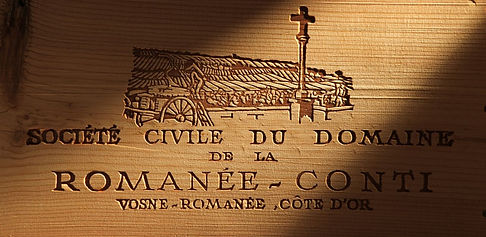

S
A B C D E F G H I J K L M N O P Q R S T U V W X Y Z
SCRE-SICI
SAAL-SAIN SAIN-SAIN SAIN-SASS SASS-SAVO SAXU-SCRE SCRE-SICI SIGN-SONO SONO-STAG STAG-SUPE
Only 4,5 and 5,0 NJP wines (Nenad Jelisic Points) are presented as the best vintages.
If for some wine behind “the best vintages” stands “none”, it means that none of the wine's vintages got 4,5 NJP or 5,0 NJP.
Screaming Eagle grapes, dominates Cabernet Sauvignon (11,7 ha) followed by Merlot (4 ha) and Cabernet Franc (2,5 ha). Small amounts of Petit Verdot and Sauvignon Blanc are also grown. (2012-09)
Screaming Eagle soils, as in the rest of the appellation (AVA) Oakville, Screaming Eagle’s soils vary greatly. From blocky red volcanic soil to gravely sandy silty clayey soil to gravel and clay. (2012-09)
Sec, French. It means that champagne contains between 17 and 32 grams per litre of residual sugar. (2018-02)
Selvapiana, Bucerchiale, Chianti Rufina, Riserva (red dry wine; 100% Sangiovese), Chianti, Tuscany, Italy, the best vintages, until vintage 2013 none. (2018-11)
Seña (red dry blend wine), Valle de Aconcagua, Chile, the best vintages, until vintage 2016 none. (2018-11)
Seppeltsfield, Para, Port Vintage Tawny (port wine), Barossa Valley, South Australia, Australia, the best vintages, 1908, 1909, 1910, 1913, 1918 and 1987; not 1989. (2018-11)
Sesti, Brunello di Montalcino (red dry wine; 100% Sangiovese), Tuscany, Italy, the best vintages, until vintage 2013 none. (2018-11)
Shafer, a US’ wine producer that is located in the appellation (AVA) Stags Leap District, which is located in the Napa Valley wine district, which in turn is located in the North Coast wine region in California. Shafer has 83 ha spread over 5 vineyards: Borderline (10 ha), Hillside Estate Vineyards (22 ha), La Mesa (7 ha), Red Shoulder Ranch (27 ha) and Ridgeback & School Bus (17 ha). (2011-11)
Shafer, Cabernet Sauvignon, Hillside Select, one of the most internationally known red wines from the United States of America. The wine is made from 100% Cabernet Sauvignon. The grapes are sorted three times. The first sorting takes place already at harvest, which is always done by hand. The second sorting takes place prior to the destemming and the third occurs after the destemming, grape for grape. The must is fermented in small stainless steel tanks with regular over-pumping of the must. The malolactic fermentation, and the aging take place in 227 litres new French oak barrels for 36 months, and then, after bottling, the wine is aged in bottle for 12 months. The wine is filtered and not cleared. Shafer Cabernet Sauvignon Hillside Select has a great aging potential, up to 20 years. (2011-11)
Shafer, Cabernet Sauvignon, Hillside Select (red dry wine), Stags Leap District, Napa Valley, North Coast, California, USA, the best vintages, until vintage 1990 none; 1991, 1992, 1994, 1995, 1997, 1998, 2001, 2002, 2003, 2004, 2005, 2007, 2010, 2011, 2012, 2013, 2014 and 2015. (2018-11)
Shafer, Relentless (red dry wine; Syrah), Napa Valley, North Coast, California, USA, the best vintages, 2002, 2007, 2008, 2010, 2012, 2013, 2014 and 2015. (2018-11)
Shafer grapes, dominates Cabernet Sauvignon and Chardonnay. Merlot, Petit Syrah and Syrah are also grown. (2011-11)
Shafer soils, consists of rocky volcanic soil that overlays weathering bedrock. The soil of such a composition is characterized by very good drainage properties and lack of nutrients. These soils give small but very tasty grapes. (2011-11)
Sherry, is a strong wine made from white grapes (Palomino Fino, Moscatel and Pedro Ximénez) according to the so-called solera method and which according to Spanish law must come from the triangular area between Jerez, Sanlúcar de Barrameda and El Puerto de Santa María in Spain. Sherry's production process is as follows: the grapes are harvested in early September, after the harvest, the Moscatel and Pedro Ximénez grapes are placed on straw mats in the sun to dry and concentrate the sugar content while the Palomino Fino grapes are quickly delivered to the winery, so that oxidation does not destroy the grapes, where they are destemmed and gently pressed while the Moscatel and Pedro Ximénez grapes undergo this process later, the pressed must, from the first pressing, is fermented in stainless steel tanks until the fermentation process is complete, the finished fermented dry wine with an alcohol strength of 11-12% is fortified to 15-19% with strong grape spirit and then it undergoes solera process. Unlike port wine, the wine is fortified after the wine's fermentation is complete. In some oak barrels during the solera process, a layer of flor (a skin of yeast) is formed during the aging and in some not. The wine, which is aged in oak barrels that have formed the layer of flor, does not come into contact with oxygen and becomes drier than the wine that has not formed the layer of flor, comes into contact with oxygen. Sherry is produced in several different styles: Amontillado (aged both under layer of flor and without layer of flor), Cream (sweetened variant of sherry, is made by sweetening Oloroso with sweet wines made of Pedro Ximénez and Moscatel), Fino (aged under layer of flor), Manzanilla (Fino that has been produced and aged in the town of Sanlúcar de Barrameda), Medium (sweetened variant of sherry, is produced by sweetening Amontillado with sweet wines made of Pedro Ximénez and Moscatel), Oloroso (aged for a longer period of time than Fino and Amontillado, and without layer of flor), Palo Cortado (rare sherry, an intermediate between Amontillado and Oloroso), Pale Cream (sweetened variant of sherry, produced by sweetening Fino with sweet wines made of Pedro Ximénez and Moscatel), Pedro Ximénez (very sweet sherry, made only of Pedro Ximénez) and Moscatel (very sweet sherry, made only of Moscatel). (2011-11)
Sicily, an Italian wine region that consists of two appellations: Etna and Marsala.
Sicily grapes, Nerello, Cataratto, Carricante, Grillo, Inzolia, Perricone, Calabrese and Nerello.
Sicily soils, dominates sulphurous soil and volcanic soil.


NJ Wines
 |  |  |  |  |  |
|---|